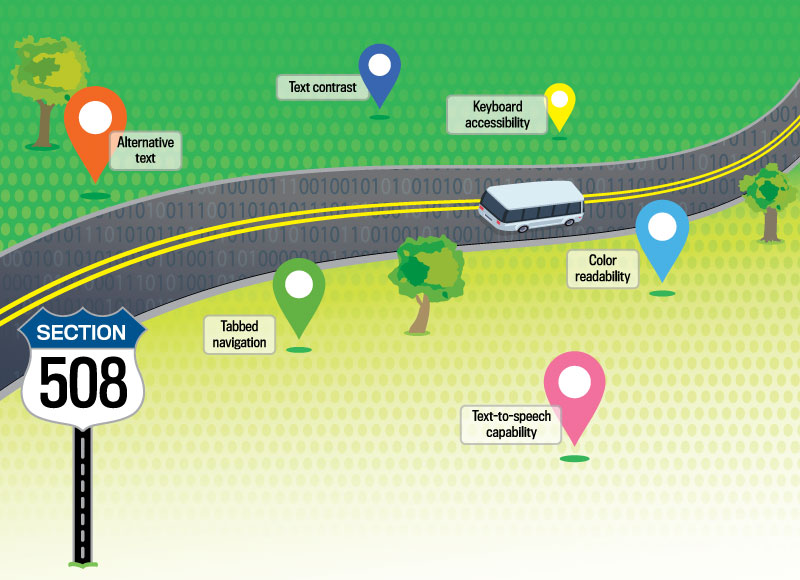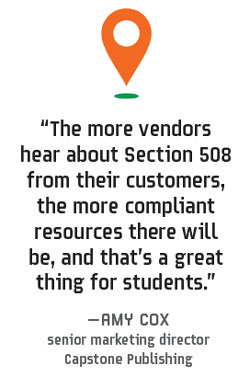Are You 508 Compliant? Making Your School's Tech Accessible To All Isn't Just a Good Idea, It's the Law.
Target, Seattle Public Schools, and the Free Library of Philadelphia have something in common. All have been sued for having websites or digital tools that fail federal accessibility standards for individuals with disabilities. Knowing the rules of 508 compliance is important for school librarians, who are often responsible for tech, including maintaining website content.

Target, Seattle Public Schools, the Free Library of Philadelphia, and Domino’s Pizza have something significant in common. All have been sued for having websites or digital tools that are not accessible for individuals with disabilities.
In recent years, hundreds of similar cases have been part of a rising tide of web accessibility litigation. In 2018, more than 2,200 such cases were filed in federal court, according to data from Courthouse News Service. That nearly tripled the 814 cases filed in 2017.
“The increase in litigation is primarily due to the continued proliferation and use of websites and web-based services,” says Chris Danielsen, director of public relations at the National Federation of the Blind.
The advocacy organization has supported numerous web accessibility lawsuits that argue school districts, libraries, and companies have violated the Americans with Disabilities Act (ADA) and/or the Web Content Accessibility Guidelines (WCAG).
WCAG are technical standards designed to help developers and technology providers conform to legal requirements in Section 508 of the Rehabilitation Act of 1973. Updated and enhanced in 2018, Section 508 requires that information and communication technology developed, purchased, or maintained by federal agencies or with federal dollars be accessible to individuals with disabilities.
Knowing the rules of 508 compliance is important for school librarians, who are often in charge of school technology and software purchases or, in some cases, maintaining or updating website content, at least for the media center. It comes into play in public libraries as well.
In one case, blind patrons at the Free Library of Philadelphia could not use Nook readers in the library’s e-reader lending program. The patrons argued that by providing Nooks, which did not have text-to-speech capability, the library violated the ADA.
That case and a similar lawsuit brought against Sacramento Public Library were later settled. Both library systems agreed to provide accessible e-readers and not to purchase inaccessible reading technology in the future.
In litigation involving Seattle Public Schools, Noel Nightingale, a blind mother of three, couldn’t use school websites and learning tools designed to provide information and resources for district students and their families.
“Without accessible web content, blind parents cannot track their children’s educational progress, help with homework and other assignments, or participate fully in school programs and activities,” says Danielsen.
Nightingale argued that the district’s failure to ensure that the sites and tools met accessibility standards violated the ADA and Section 504 of the Rehabilitation Act of 1973. Both laws prohibit discrimination on the basis of disability and require reasonable accommodation and equal access.
The case resulted in a landmark settlement and consent decree. Seattle Public Schools agreed to make specific changes to its software, platforms, training processes, and procedures, making its sites and tools accessible for users with disabilities.
“The district replaced its web platform and migrated district websites and sites for its 104 schools to a newer, more accessible platform,” says Nancy Petersen, Seattle Public Schools’ director of enterprise applications and data services. “We also implemented an internal process to vet school software products before use and changed our contracting processes to require new electronic products and applications to be ADA accessible to WCAG 2.0 AA level.”
To comply, Seattle Public Schools also needed to train staff on how to create accessible electronic materials. “Accessibility features in office productivity tools are not easy to use,” says Petersen.
The district reevaluated documents, PDF files, images, videos, audio material, graphics, and fonts. It also engaged in a process to ensure that third-party tools and products procured by the district were accessible for all.
“We found that very few educational tools on the market met our legal accessibility requirements,” Petersen says. “We had to educate many of our vendors about ADA accessibility and WCAG compliance.”
 Increased awareness
Increased awareness
Though several school districts and public-serving entities have made progress in understanding the importance of accessibility and in becoming Section 508 compliant, many others are still facing legal issues.
Certain K–12 and higher education complaints are a result of mass filings, a single plaintiff, or an advocate filing hundreds of court cases or civil rights complaints. Other complaints—including high-profile cases involving companies such as Target (settled for millions of dollars) and Domino’s Pizza (currently being litigated)—have been filed in more traditional legal actions.
“Some of this is a result of [individuals with disabilities] and advocates being more aware of their rights to seek legal remedies when their accessibility concerns are not addressed,” says Danielsen.
The Nightingale settlement decree has had broad positive impact in the education context, according to Danielsen. For example, he says the decree urged developers to improve the K–12 software used by the school district.
“The court extended the decree to account for the remediation of a specific K–12 software that Seattle Public Schools deemed necessary,” Danielsen says. “Changes made by software developers in one district can improve access for students and parents in other districts that use the same software.”
Amy Cox, senior marketing director for Capstone Publishing, echoes that notion. “Educators should add Section 508 compliance to their technology criteria and ask vendors when they intend to be compliant,” she says. “The more vendors hear about Section 508 from their customers, the more compliant resources there will be, and that’s a great thing for students.”
Danielsen says the Nightingale case also helped bring attention to the fact that blind parents (and by extension blind staff, faculty, and volunteers) are adversely affected when school district websites and web services are inaccessible. In that way, he says the decree has increased awareness of web accessibility in the K–12 world.
Cox agrees that awareness is important—at all levels in a school district. For example, she notes that school technology specialists may be aware of 508 compliance, while most site-level educators are not. “These educators are often looking for accessible resources but do not really have an idea of what that might mean or where to start,” she says.
Impactful features
For Capstone, makers of the educational database product PebbleGo, digital education on Section 508 initially came from hearing about school districts that needed compliant products.
Cox says Capstone had a history of serving reluctant and struggling readers. “We have always understood that certain design elements like text layout or use of certain fonts can help those readers,” she says. “But we had little experience with the needs of students with physical disabilities.”
PebbleGo is a collection of databases geared to the specific needs of K–2 learners. The product includes read-aloud audio recorded by professional voice-over artists. “It would be easy to assume that audio would be enough accessibility for a blind student, but that’s not true,” Cox says.
Section 508–compliant code for PebbleGo ensures that the screen reader can find both the page content and the navigation that allows students to access that content. “A feature like read-aloud audio is great, but not if a user cannot find the log-in button in the first place,” says Cox.
Jared Smith, associate director of WebAIM, a Utah nonprofit web accessibility organization, cautions that the most important accessibility features will vary for different users. However, WebAIM research shows that impactful features of accessible web content typically involve text contrast, alternative text for images, links, buttons, and document language.
Smith would also add keyboard accessibility to that list. For example, he says, “Users who cannot use a mouse, touchpad, or touchscreen can interact with and navigate within a web page using the keyboard instead.”
A Section 508–compliant approach would eliminate barriers to keyboard use. This may include links or buttons in a webpage that can only be activated by a mouse or touchscreen. Similarly, Cox says that colorblind students or students whose motor skills prevent them from using a mouse may need to use tabbed navigation.
Other features that help make online content more accessible include remote access, use of assistive technology, alternative formats and methods for presenting information, captioning audio, and considering the impact and readability of certain fonts and colors.
The right thing
Smith says it is important to start with commitment. Often, he finds that the biggest challenges organizations face in getting their websites and technology Section 508 accessible are more systemic than technical.
“Organizations that do not have a clear commitment to accessibility, including a policy and implementation plan, adequate resources and staffing, and sufficient expertise will typically struggle,” he explains. “With these components in place, technical obstacles to achieving compliance—like vendor availability, software compatibility, training, etc.—are easier to overcome.”
Optimally, Smith believes that everyone who manages, creates, or influences web content has some responsibility for ensuring accessibility. In most schools, the technology or web director will have primary responsibility for the technical aspects of web accessibility. Some schools have accessibility coordinators who are charged with ensuring that entities comply with the ADA.
Petersen acknowledges the technical and procurement challenges associated with becoming Section 508 compliant. However, she sees the positive impact. “Seattle Public Schools’ communications and tools are more accessible for students, families, and community members,” she says.
Cox appreciates that legal liability is part of the reason entities that receive federal funding should strive to make their websites and educational software compliant. But it is not the only one.
“A disability should never be a barrier to access—either for a student with a disability or a parent with a disability interacting with school resources,” she says. “Ensuring that digital spaces are as accessible as our physical spaces is the next frontier. It is also just the right thing to do.”
 Kelley R. Taylor is a freelance journalist and writes frequently about law, health, and education.
Kelley R. Taylor is a freelance journalist and writes frequently about law, health, and education.
RELATED
The job outlook in 2030: Librarians will be in demand
The job outlook in 2030: Librarians will be in demand
ALREADY A SUBSCRIBER? LOG IN
We are currently offering this content for free. Sign up now to activate your personal profile, where you can save articles for future viewing






Add Comment :-
Be the first reader to comment.
Comment Policy:
Comment should not be empty !!!